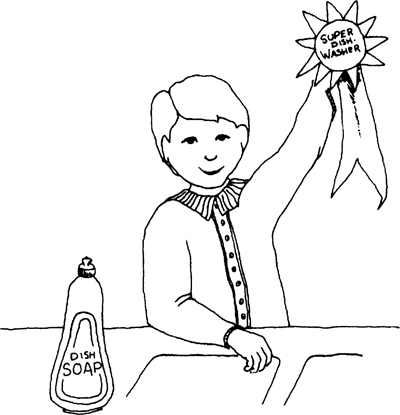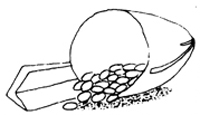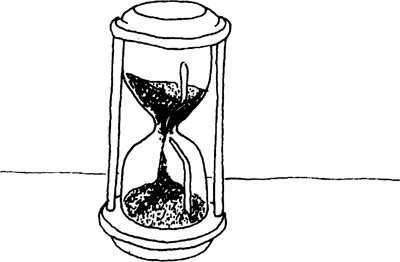

7: Offering Incentives and Rewards
Why are incentives, rewards, and logical consequences useful? Because they:
• Prove to the child that she can do it
• Motivate with outside forces until the inner motivation is developed
• Keep the task interesting
• Get the child over a fear
• Help him finish and feel successful
If a child is going to hurt himself, someone, or something, he has to be stopped by whatever means pops into your mind. But, if the problem is not so immediate, there is time to try other ways to change a bad habit or start a good habit. This is where incentives, rewards, and consequences can be used. It takes time to learn to use these devices, just as it takes time to learn to use a new appliance such as a microwave oven. Some parents find it stimulating to read at least one parenting book a year to get new ideas on how to use these and other principles.
Incentives and rewards are motivators from outside the child and can be anything the child likes: books, privileges, strokes, food, or money. A good incentive may be needed in the beginning of training or to perk up interest, but it can gradually be eliminated. They start to become bribes, however, when the reward has to keep getting bigger to initiate the desired behavior. We need to emphasize that incentives are not used all the time for everything. On the other side of motivation, consequences occur when the child makes a wrong choice. Natural consequences happen because of the nature of the world—if you don’t wear gloves on your hands in freezing weather, they get cold. A logical consequence is structured by the adult to be the logical result of misjudgment on the part of the child. It usually involves withdrawing the related privilege or restoring the undone as much as possible. Consequences are not to be confused with threats. In fact, every action doesn’t have a consequence. In the real world, for example, most of the time we don’t get caught for speeding.
Incentives or reinforcers can be used as a reward when trying to change a behavior, when trying something new, or when the situation is slightly threatening. If you make a promise for a reward, you must keep it to maintain trust, but promises don’t have to be made for everything. In the book How to Teach Children Responsibility, Harris Clemes and Reynold Bean state “Working for rewards is a way children develop a goal-orientation.… Concrete rewards help children establish concrete goals.… There are times in the child’s life when material rewards seem to be most important. As children learn that material rewards can be gained by them as a result of their performance, their self-confidence increases, and their sense of responsibility grows. This allows them to develop alternative reward systems.”
According to psychologist Marcia McBeath, there are three types of incentives: intrinsic, social, and extrinsic. The intrinsic reward is the good feeling the child gets when something has been done well. When someone gardens, sews, cooks or reads because he likes to or because he knows he’ll feel good when he finishes, he is reacting to an intrinsic incentive. The extrinsic reinforcer—the grade, a movie, treat, or privilege—motivates from outside the person. These motivators can serve to entice the child to do something until she has the inner desire. The social reward is usually a verbal comment expressing appreciation, encouragement or awareness of a job well done. When the extrinsic token is combined with a social expression, the token can later be withdrawn and the social reinforcer will be sufficient.
Rewards and consequences are stimuli from outside to be used while the child develops the mature, intrinsic motivation and self-discipline from within. In this chapter, we deal mostly with positive motivators.
Incentives and rewards are fun because they can be planned with all the pleasure of anticipation or they can be spontaneous with the merriment of surprise, whereas consequences have to be logical, fair, and consistent. The following is a collection of rewards and incentives that we have tried or that have drawn our attention. You have to keep working to find the right blend of rewards and incentives to keep your child motivated. It is as though each child has his own secret combination and we have to find the right set of numbers to unlock them. Use the ideas that fit your mood and circumstance. If you have other ideas, we would love to hear them too.
VERBAL STROKES
As already discussed, social rewards are the most successful in bringing about change in a child’s behavior. These verbal expressions of encouragement and appreciation don’t cost money, either. Children change their behavior to receive these rewards or “strokes.” Strokes can be positive or negative, and children prefer one over the other by the time they are seven or eight years of age depending on which satisfies their need for attention. Negative responses don’t bring about positive behavior; they only reinforce the undesirable. If you want to encourage a behavior, then give positive comments about what is really right.
Strokes can be general: “You are a good girl.” Strokes can be specific: “You did a nice job washing the car.” (When you are complimenting a job, it is better to compliment the job well done than the personality.) Strokes come in varying degrees of vigor: “I’m proud of you!” or “I’m really proud of you!” More emphasis means the reward is greater. Positive strokes are the best rewards. We all seek them, we save them up, and they are building blocks of self-confidence. Serve them generously.
General strokes are often difficult to accept. “You are a good boy!” is too general because nobody is totally good. If the child can’t honestly accept the compliment, he may be forced to do something to prove you wrong. For example, a baby boy had recently been born to the Gundersons. During a friendly visit from an old roommate, Anne Gunderson praised her three-year-old son with “Scott is such a good big brother!” After Anne told her friend good-bye, she discovered Scott in his brother’s room vigorously “powdering” the baby. Powder dust filled the air and the baby was choking frantically. Scott had justified that he was not a “good big brother.” Indeed, he resented the extra time and attention spent on the baby. Anne could have said, “Scott brings me diapers to help!” This specific comment would alleviate the need to retaliate by proving one wasn’t so “good.”
By making your positive strokes deal with specific details, the child knows what she or he did right. “I can tell by how smooth the covers are that you worked especially hard making your bed this morning!” or “I was so pleased to see you put your plate in the dishwasher without being asked.” When complimenting the individual, keep in mind that a stroke that mentions a physical trait or something a child really isn’t responsible for, such as “Becky, your hair is such a lovely color of red,” isn’t nearly so meaningful as a compliment directed toward her ability or personality: “Becky, you take such good care of your hair!” (ability) or “It’s fun to be with you!” (personality). Positive reinforcement, encouragement, compliments, strokes, and appreciation will do a great deal in helping your child learn to do household chores or take care of personal grooming. If it is not your nature to give these verbal expressions, you may need to create some sort of tally system or incentive to help you change. By taking the time to make this change in your life to a positive response system, you will get big payoffs.
There are times, especially with the young child, when the parent needs to use a little forceful action to start the correct behavior. For example, Sylvia was trying to get her three-year-old to pick up the books spread all over the floor. She grasped the girl by the hand, took her to the books, put her left arm around her daughter’s waist, and bending over together, they picked up and put away a book. Even though the action has been completely controlled, the mother could then offer verbal encouragement. “It looks better already. Now let’s do another one.” Soon, Sylvia could withdraw physically, but still help the child side by side. Sylvia had to insist on the first success in order to have something to build her positive comments on. As the child did more on her own, she had more successes to build upon. Success breeds success.
LOVE NOTES
Love notes can be a lot of fun once you start looking for ways to write your appreciation (social reinforcers). One morning, when Bonnie was tempted to scold five-year-old Mattie for dawdling, she decided to make his bed for him and put a smiley-face note on it that read, “A secret fairy was here and made your bed. Surprise!” He was thrilled and asked his mother to read it for him. He showed everyone the yellow circle and asked each if they had made his bed. He put the smiling face on his clothes line (a string from corner to corner of one wall on which school papers and art work were hung with clothes pins) and talked for days about the fairy making his bed. Sometimes such a charitable act will trigger other acts of kindness. Anyway, it was more fun than the usual scolding. Now, once in a while, when Bonnie and her husband Bob go to bed, they find a love note on the pillow: “I love you Mom and Dad.”
At the elementary school, the children get “Happy Grams” and “Glad Grams” which are displayed on a large bulletin board in the main lobby of school, the Hall of Fame. One says, “Shawna, sensational, you’ve passed the rhyming phrases test!” and she gets to take it home on Friday to show her parents—a good way to reinforce effort and achievement. One family has a wall in the den on which to put the “Happy Grams.” They hung a big sign that read, “Warm Fuzzies, we all need them.” Then they started putting up warm, fuzzy notes for each other. “Teri, thanks for helping today,” or “October 9, the day Mom got the mending caught up.”

The Johnson family started Good Deed Sheets for each child and parent to record for themselves the extra things they did for the family. This way, the family members didn’t have to wait for someone else to notice their efforts. We all need to recognize the things we are doing—to have a sort of “victory list.” Adding up accomplishments or good deeds can help build self-esteem.

RIBBONS, CERTIFICATES, AND COUPONS
Pam used the incentive method to motivate a habit change: taking off clothes right side out (saves lots of time on laundry day). Instead of nagging, she packed a suitcase with Dad’s big pajama bottoms, socks, and sweat shirt. At family council, the game was to put on Dad’s clothes and take them off right side out. That means pulling the pant leg and the sock from the toe instead of peeling them down from the top. Each child who was successful (and she made sure they all were) received a coupon redeemable for a treat. Then Pam explained that another coupon could be earned by each person whose clothes came through the laundry on wash day all right side out. After issuing success coupons for only three weeks, Pam had modified an undressing habit that had amounted to many work hours for her.
A year later, as a reminder (they had slipped a little), she handed out a blue ribbon with a gold seal on the top which read “Congratulations—Clothes Right Side Out.” She awarded the ribbon to Jill at family council so everyone would see it—a method of ignoring the lack of effort by the other family members. Often, rewarding success of one motivates the others to the same action. Again, be careful not to foster the wrong kind of competition between siblings. The best kind of reward is when everyone has a chance to win: “Everyone who has clothes all right side out next week gets a blue ribbon.”
Everyone loves to receive certificates. Make your own by using ideas from children’s coloring books or newspaper ads. These could be awarded at family council, at dinner, or left propped against the bed pillow.

INSPECTIONS
At Glennon Heights Elementary School, the class with the cleanest room hosts a “mop doll” for a week. The custodian gets to be the judge. There are a lot of tricks you can use to keep things interesting at home, too. Here we described the point-inspection system for the bedroom. Pam Brace and Peggy Jones, two sisters living in Vancouver, Washington, trade off being house fairies to each other’s families. One will dress in a ballerina costume, using a vacuum attachment for a wand, and show up at her sister’s house for a bedroom check. Each person who passes the inspection gets a little wrapped gift (inexpensive trinket or game). If they don’t pass, they do not get the gift—a logical consequence—but the incentive is strong to keep it neat for the next time. Little notes and tiny surprises are left by the house fairy from time to time. Two neighbors who heard about this idea, agreed to trade off inspections. They had regular, planned inspections every Saturday for three weeks and in between times the child’s own mother left notes. When it was close to Easter, they were left in plastic Easter eggs. One such note read as follows:
On my way to the Fairy’s Track Meet
I stopped in your room to take a peek.
Your room was so nice, picked up and clean,
I had to leave all twenty jelly beans.
The House Fairy

For the child whose room wasn’t neat, the note read as follows:
On my way to the Fairy’s Track Meet
I stopped in your room to take a peek.
Twenty jelly-bean-eggs were for you,
But I had to subtract a few.
Better luck next time!
The House Fairy

PRIVILEGES
Work before fun gives incentive to get it done. Generally, a basic routine that must be done before school, television, or play is fair. The simple idea of having the child dress before breakfast helps him to do it in half the time it would take to dress after breakfast. An immediate incentive: “At one o’clock, everyone in the family whose room is cleaned and vacuumed can go with us for a family swim.” When the time arrives, only those who have completed the task get the reward, even if it means hiring a baby-sitter. Be firm.
For the young child, immediate incentives are best, such as the daily star work chart shown here. In the finger plays of morning routine (here), finishing is the immediate reward. The privilege is freedom after the responsibility has been met. The advantage of good supervision is that verbal expressions can also be dealt immediately. Put something less desirable before something more desirable. (“When you have your pajamas on, we will read a story.” After you have finished your bedroom, we will go to the library.”) That means you have to know what motivates your child—not everyone likes a story or the library.
Anything the child wants to do can be an incentive, but remember, not every privilege should hang on a mountain of work, because the motivation can be squelched. There are parents who use the next pending event to bleed the turnip. Keep the incentive simple and reasonable. The objective in the beginning is to help this child succeed and in the end, success is the greatest motivator.
FOOD
Food can be used as an immediate reward, especially to change behavior. For years we have heard how food brings about success with slow and retarded children. Special learning classes offer points to earn goodies for good work. Immediate food rewards can also be a tool to improve behavior and form good habits in normal children. Important principles for using this behavior modification are as follows: (1) work with only one behavior change at a time, (2) keep the task simple, (3) make the reward minimal, (4) be unwaveringly consistent in giving the reward only when all the desired behavior is performed.
Do you realize what five little M & M candies can do? They can motivate a child to sleep in his own bed, overcome the fear of going to Sunday school class alone, or get him to flush the toilet and wash his hands. They act as incentives and immediate rewards. Creating proper incentives is challenging, but it results in positive changes when coupled with positive strokes.
How do the M & M candies work? “I have five M & M candies in my pocket for you after Sunday School if you stay in your class.” If the child doesn’t quite make it, say, “I’m sorry, son. Perhaps next week you can stay with your teacher.” Don’t give the reward unless the behavior was completed. You may need to use a gentle one-time reminder of the pending reward beforehand: “I hope you sleep in your own bed all night, so you can have five chocolate-coated raisins in the morning.” (Repeating the incentive over and over turns it into a bribe.) In the morning, praise and approval come with the candy reward: “I’m so proud of you for sleeping in your bed. I knew you could do it. Doesn’t it make you feel good?” Remember that using the social or verbal recognition will make it easier to eventually drop the extrinsic candy reward. Incentives don’t have to keep getting bigger, like bribes. It took a total of only twenty-five M & M candies for the boy to go to class alone. Soon he forgot all about the candy reward and found enough reward from the attention he earned discussing what he had learned in the class.
You have to be careful in using food as a reward or you may teach bad eating habits, so don’t go overboard. But, we have to admit, food can be a powerful motivator. “Everybody who picks up and puts away twenty things gets a popsicle.” You can’t be handing out popsicles everytime you want something done, but if you were ready to have a treat time, why not have a short pick-up time first. In fact, stopping to pick up is a good habit to start. The progress chart called Ice-Cream Sundae, as shown here, is a fun, longer-term incentive. Popcorn is also a good incentive. Keep a sensible balance; the leverage will be lost if you are doling out handfuls of sweets every time the child does something.
You may not have thought of it this way, but cooking has a food reward—eating. Washing dishes does not have the same appeal as mixing up a batch of chocolate chip cookies. Try including as much of the clean-up as possible with the preparation, where the incentive is. Besides, most bowls and pans are easier to wash right away unless they need soaking. It is easier to put away the salt, sugar, flour, and cinnamon one at a time, as each is used, than to wait until the end, when all the containers have been dusted with flour and everything needs to be wiped off. An incentive here might be to say that you can’t eat until the preparation mess is cleaned up.
One school teacher in a small town formed an ice-cream club for good spellers and perfect-math-paper producers. A certain number of perfect papers merited an ice-cream treat: single scoop, double, or triple scoop; hot fudge sundae; or banana split. As the child earned the reward, the teacher drove him or her to the ice-cream shop for the one-to-one reward. You can see how easily parents could set up such an incentive plan for a desirable behavior or habit. It has a double reward of food and adult attention.
CHANCES
The Talbots, a family with five children, tried an incentive technique based on the “positive image campaign” used in a California school. Adapting this idea at home, Mrs. Talbot gave out chances for good behavior and helpfulness in the form of rectangular pieces of colored paper; one chance for fifteen minutes work, three chances for music practicing, and so forth. The child put his or her name on the chance and slipped it into a decorated box on the kitchen counter. At the end of the day, a drawing was held and the winner picked a reward from the “goodie box” (instant pudding, Twinkies, individual cereals, Snack Pack, peanuts, etc.). This may sound like it took a lot of time, but Mrs. Talbot claims it actually took less time—working with the positive meant less policing. After the drawing, the chance slips were taken from the box and saved. When a child had one hundred chances she earned a movie ticket. Mrs. Talbot said it was the best motivation system they had tried, because it offered immediate rewards for the positive behavior. The parents spent less time calling the children to do their work, practice music, or finish a job.

CHALLENGES
“Let’s see who has the most seeds in their tangerine,” challenged Bonnie one day in a desperate appeal to get her family to eat the tangerines. They preferred the no-seed navel oranges, but Bonnie couldn’t throw out thirty pounds of tangerines just because they had seeds! Five years later, her children are still counting tangerine seeds—but, obviously, not the same thirty pounds. Be inventive with challenges.
The challenge: “Can I get dressed before the timer rings?” “How many diapers can I fold in ten minutes?” “Will I get the dishwasher emptied during this commercial break?” You may not believe this, but the McCullough kids have been known to get all their Saturday morning chores done during television commercials between cartoons. Children love to play Beat the Clock. The challenge should not be a person-against-person one because resentment can develop. There is enough rivalry between siblings without nurturing it. For example, if we tell Matt (five) and Becky (eight), “Let’s see who can get dressed first,” the one who loses will cry. It would be better to say, “Let’s see who can be dressed before the timer rings in ten minutes,” giving them both a chance to win. Another method that would instill cooperation may be to say, “As soon as the two of you get dressed and come together…,” leaving an option for them to help and encourage each other.
MONEY
Money can be used as an incentive, if you heed the same cautions that need to be used in other areas; with moderation and simplicity, and without escalation. Karen brought home twenty dollars’ worth of nickles. Her husband had grown up in the South and wanted their children to start learning to say “yes sir,” and “yes ma’am.” Karen gave each child a nickle when he or she answered with the new responses—an immediate reward, better in this case than saving up points and giving the nickles out later. It worked. Three years later, the children are still answering “yes sir” and “yes ma’am.”
If a child wants money for a special purchase, it can be enough motivation for him to try something new. When Wes wanted a dollar to go bowling, his mother offered it to him for scrubbing the kitchen floor, a task he had never tried, but he did it and was paid. On another occasion, when a choice of jobs was given, without pay (it was a family crisis to get ready for company), he chose to scrub the kitchen floor because he knew how. All of Chapter 10 deals with money and the child.
One mother used money as reward and consequence to train her preteens to pick up after themselves. She gave each child fifteen dimes in a baby-food jar. “This is your spending money for next weekend. Every time I pick up something of yours I get one of your dimes and you can have all the dimes left in your jar on Saturday.” She set the jars in the kitchen window. The first week, Mom had enough to go out for Saturday breakfast. The next week her earnings would only buy a candy bar. The children insisted that to be fair, Mom and Dad should also have a jar of dimes, and if they could find something of Mom’s or Dad’s left out, the children could collect from the adults. Another family used a similar idea, with the family recreational allotment in the jars. The money left in each person’s jar determined the amount he or she could spend for a restaurant dinner on Friday evening. (They normally went out as a family anyway. This was just a way of drawing attention to a new habit.)
Sue Monson used play money in her school classroom much like the Talbots used the chances, giving out work dollars for effort and accomplishment. The last ten minutes on Friday afternoon she held an auction for things like posters and bulletin board display items that weren’t needed anymore at school. The kids loved it and liked to plan how to spend their “money.” The same idea could be used at home just for fun. Wouldn’t it be a thrill to get paid five hundred dollars for doing the dishes?
Don hides pennies and dimes under the bed, next to the radiator, and under the lamp to motivate and test how well his children clean. He got that idea from a sergeant in the Army. If the child usually receives an allowance, hide that amount in small coins throughout the child’s room; if the room is thoroughly cleaned all the money should be found. Caution: no guarantee the child will clean as she hunts! The money might need to be marked with colored tape so it won’t be confused with other money that could be in the room.
THE UNEXPECTED RESPONSE
An unexpected reaction by a parent can generate a shock effect in the child—and give the parent control. For example, when Judy’s four children start to quarrel over the dishes, Judy stands up on the table with a wooden spoon in her hand and starts singing “Love at Home.” (Who can fight with that going on?) An elderly schoolteacher, weighing about two hundred pounds, lays a great big kiss on any misbehaving fifth grader—works better than scolding, threats, or spanking. If you can’t sleep at night, try dreaming up unexpected positive responses.
When one of Sue’s third grade students started making weird, disruptive noises during a spelling test, Sue quickly said, “Oh, let’s stop and listen. Here, Tom, stand up on the desk so we can see and hear you better. Now make those noises for us.” This atypical response brought silence from Tom and put Sue back in control. At home an unexpected positive response can be helpful too. When Bobby starts moaning about doing the dishes, say, “Hey, Bobby, slow down. I want to write all those excuses on this paper. We’ll number them and next time you can just refer to the number.” Then begin writing down his complaints and excuses.
WATCH FOR THE RIGHT INCENTIVE
Sometimes, if you are watching, motivation opportunities will surface. One mother, whose teen-age son had extreme difficulty keeping his room clean, found a clue in her son’s request for a good feather pillow. “Yes, son, you can have this pillow as long as you make your bed every day.” On other occasions, the parents had tried offering him the moon without getting any improvement in the bedroom. Although the bedroom was a major problem, they didn’t want to drive their son away from home by making it a constant issue. He still needed their adult parentship and the atmosphere of a loving home. Part of this incentive game is finding the right key. One day the boy forgot to make the bed and, without comment, the pillow was taken away. That day the boy made the bed when he got home from school, redeeming the pillow, and it didn’t happen again. By this time, the boy had learned he could make the bed quickly and he liked it better that way. The incentive had helped overcome the hang-up. When he saw the bed was neatly made, he felt good, he knew it pleased his parents, and his self-esteem shot up.
Children want to succeed, but sometimes they need to know that their parents will help them with reminders, encouragement, and love. Being parents is not an easy game, and you’re never sure that you have won.
Be aware of local or seasonal ideas that might trigger incentives or add interest. Little Sarah (two years) thought up the idea of the sock for a Dust Muppet and a rag was a Dinosaur Eater to eat (wipe) up a milk spill. One night, after hearing a chapter from Pippi Longstocking, five-year-old Mattie said, “I want to be a thing finder.” With that bit of interest, you could get a bucket or apron, pin a Thing Finder sign on him and put him to work cleaning under the sofa cushions. Add more fun to your family life with rewards and incentives.